Turtles are reptiles that live in water or land. There are over 100 species of turtles in the world.
Maryland has 13 native species of turtles, which ranges from musk turtles, box turtles, and snapping turtles. Some turtles in this article are also classed as threatened.

Alongside this, there are 5 native species of sea turtles in the Maryland waters and 3 non-native species of turtles, which are all found in Maryland.
In this article, we are going to discuss the 13 native turtle species and the non-native species that can be found in Maryland.
Native Turtles To Maryland
Bog Turtle
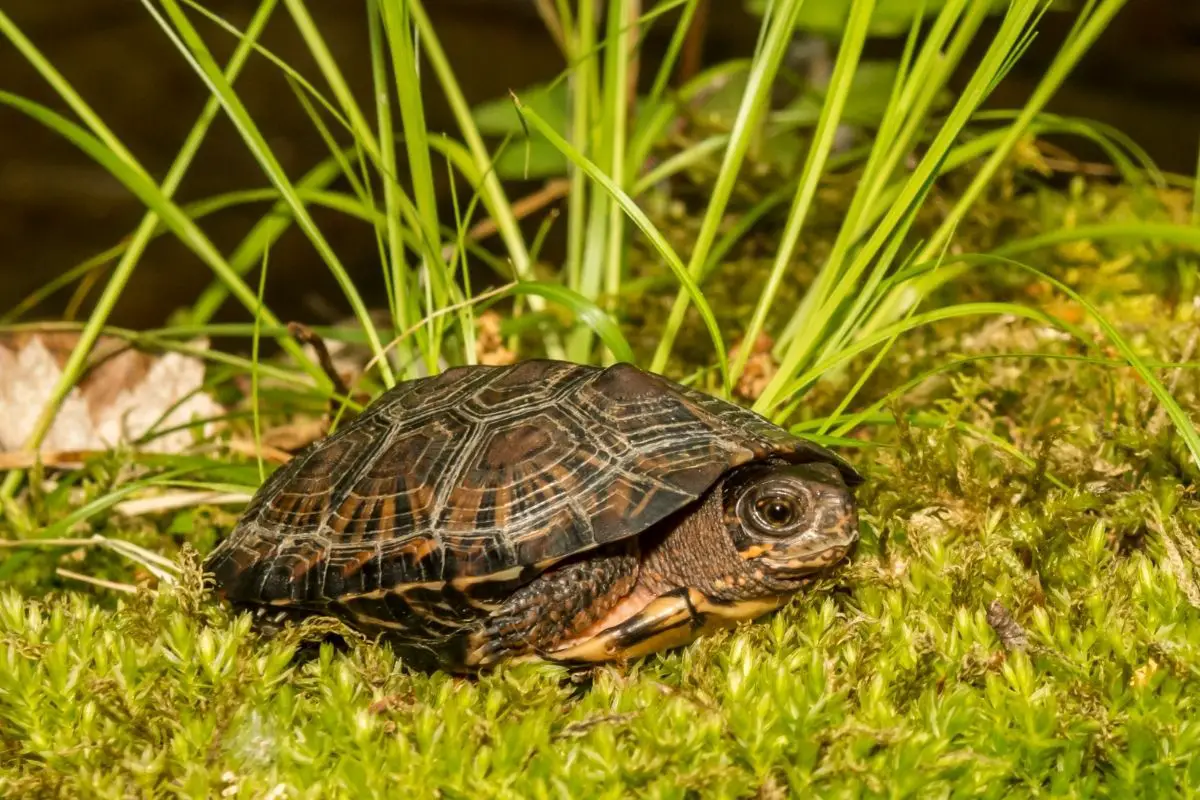
- Name: Glyptemys Muhlenbergii
- Family: Emydidae
- Maximum Size: 3 ½ to 5 inches
- Lifespan: 40 years
Box turtles are known as one of the smallest species of turtles that can be seen in North America.
They are mainly spotted in open areas of the central and northern counties of Maryland. However, they have recently become classed as a critically endangered turtle species.
Sometimes this turtle can be referred to as the Muhlenberg Turtle. Appearance-wise, these turtles have a dark brown or black or an olive-colored keeled shell. On the scutes, there may be a red or yellow star-like pattern.
The Bog Turtle has an omnivorous diet that consists of invertebrates, earthworms, and mollusks.
There will also munch on vegetation occasionally for a balanced diet. They are really active when the sun is out and can eat either in the water or on land.
Diamondback Terrapin
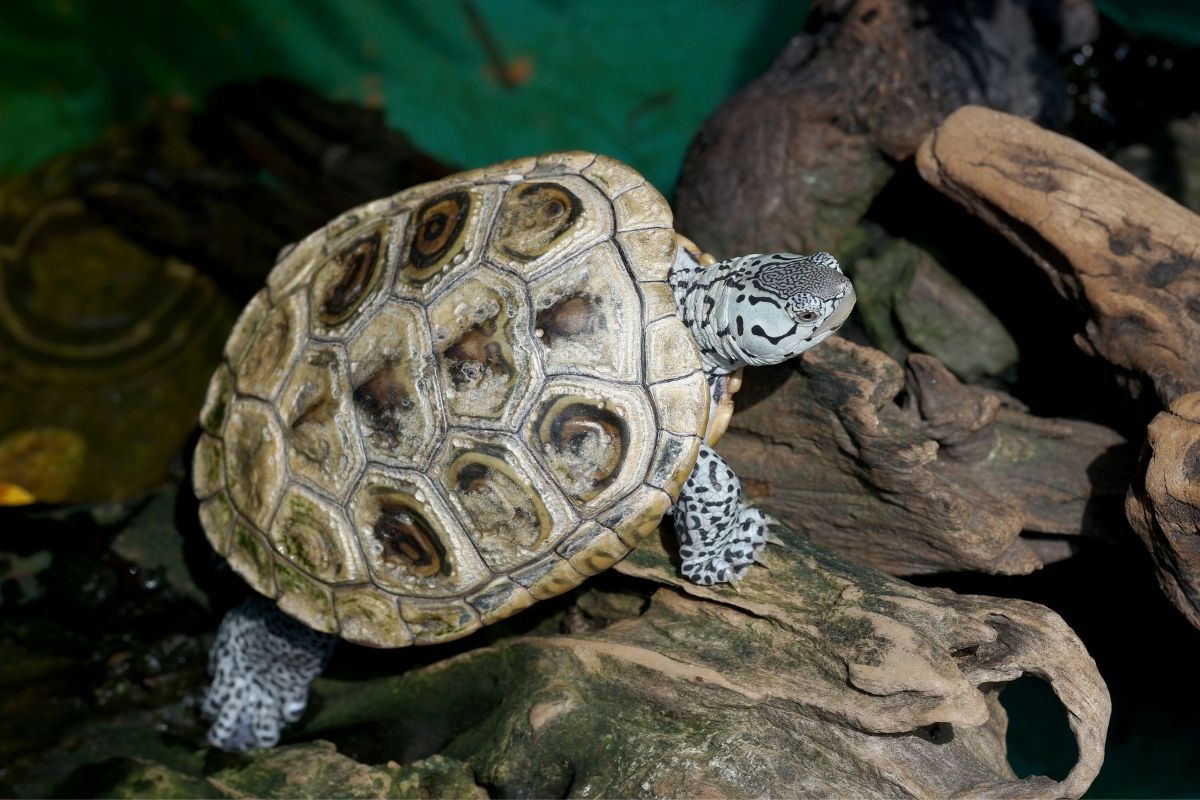
- Name: Malaclemys Terrapin
- Family: Emydidae
- Maximum Size: 4.5 to 9 inches (depending on if they are male or female, males are smaller than females)
- Lifespan: 25 to 40 years
The Diamondback Terrapin enjoys the estuary and coastal shorelines in the South of Maryland. Yet they can also be seen in marshes as well; these turtles love water.
It is a common sight to see these turtles swimming in water with just their head poking out of the water.
These turtles have brown, gray, black, or even yellow wedge-shaped shells. The scutes on their shell form perfect circles, and you will see a keel ridge running down the spin of the shell as well.
When it comes to what they like to eat, they have a balanced diet of vegetation alongside mollusks, shellfish, winkles, clams, and crustaceans.
Eastern Box Turtle
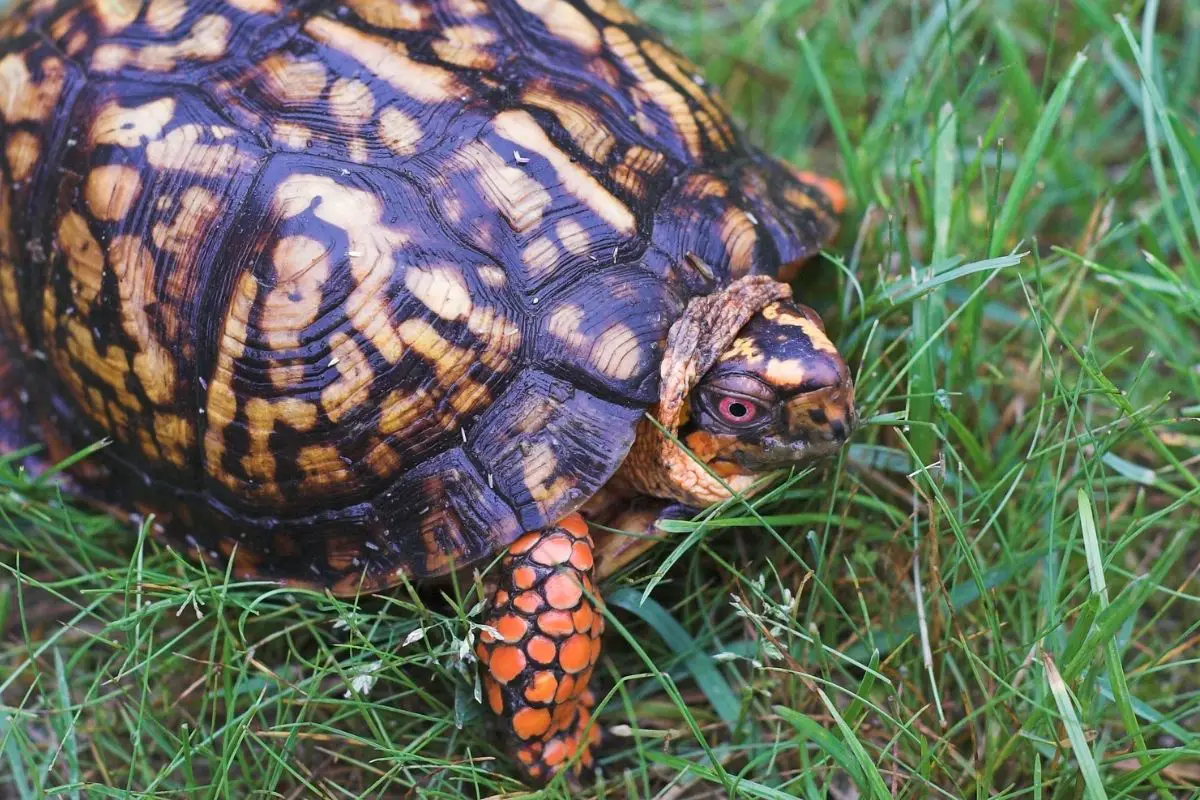
- Name: Terrapene Carolina Carolina
- Family: Emydidae
- Maximum Size: 4 and 7 inches
- Lifespan: 40 years
The Eastern Box Turtle is another species that are native to Maryland and are quite common. They have a dark brown shell that is domed quite high.
Also, you will notice orange and yellow markings on the upper side of their shell. Something unique about these turtles is that it is known that they can actually regenerate their shell when it becomes damaged.
These turtles can travel around 50 meters every day when looking for food. The Eastern Box Turtle is an omnivore and generally eats a mixture of plants, invertebrates, and fish.
You will typically see this species of turtle in grasslands and marshy areas. Yet they do like woodlands as well. When they have found their home, they create a territory of 230 meters. Typically, they will live near a pond or a stream.
Eastern Mud Turtle
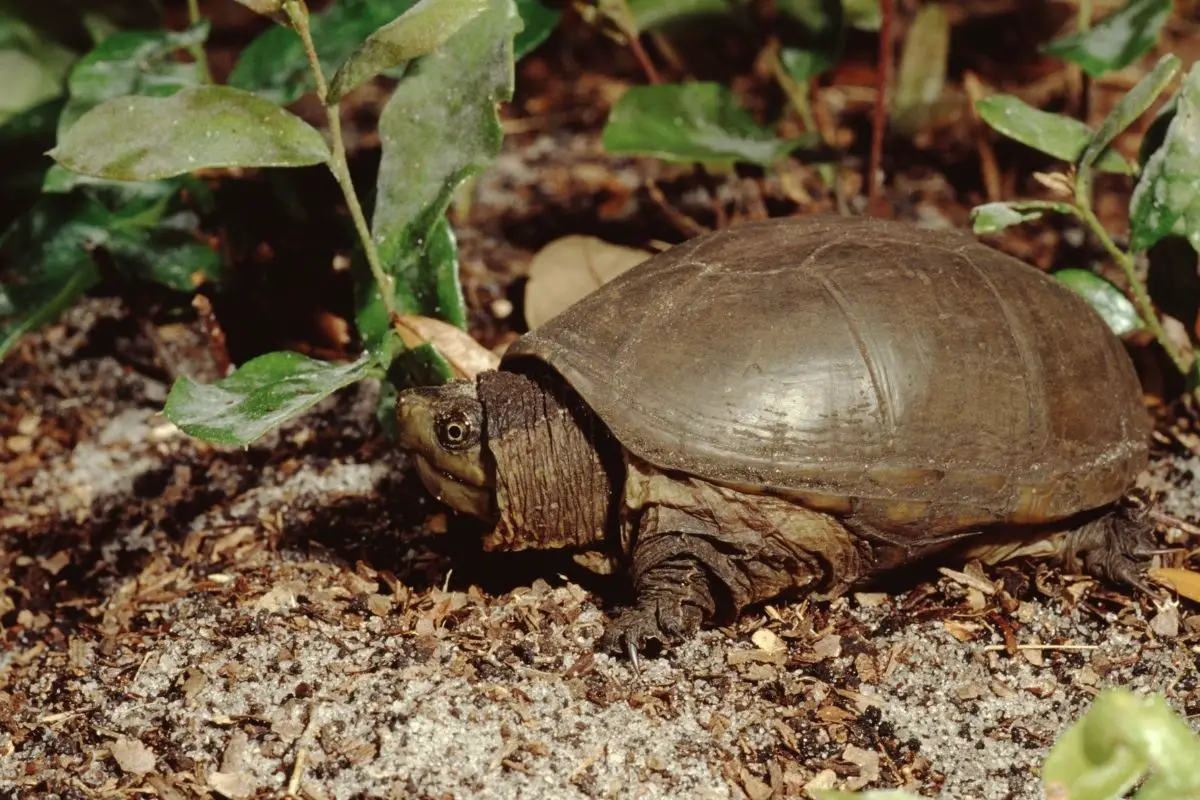
- Name: Kinosternon subrubrum
- Family: Kinosternidae
- Maximum Size: 3 and 5 inches
- Lifespan: 50 years
The Eastern Mud Turtle is often seen in the coastal plains of Maryland. This is because they enjoy slow-moving water. Therefore, you can see them in bogs, swamps, and tidal marshes.
The Eastern Mud Turtle prefers to move on land and doesn’t like to spend too much time near water.
This species of turtle has an oval-shaped yet smooth shell, which can be colored from yellow to brown. The sides of the shell drop quite a bit, which makes the shell itself look slightly domed.
Eastern Mud Turtles will eat plants, but they mainly consume fish, snails, worms, and mollusks.
Striped Mud Turtle
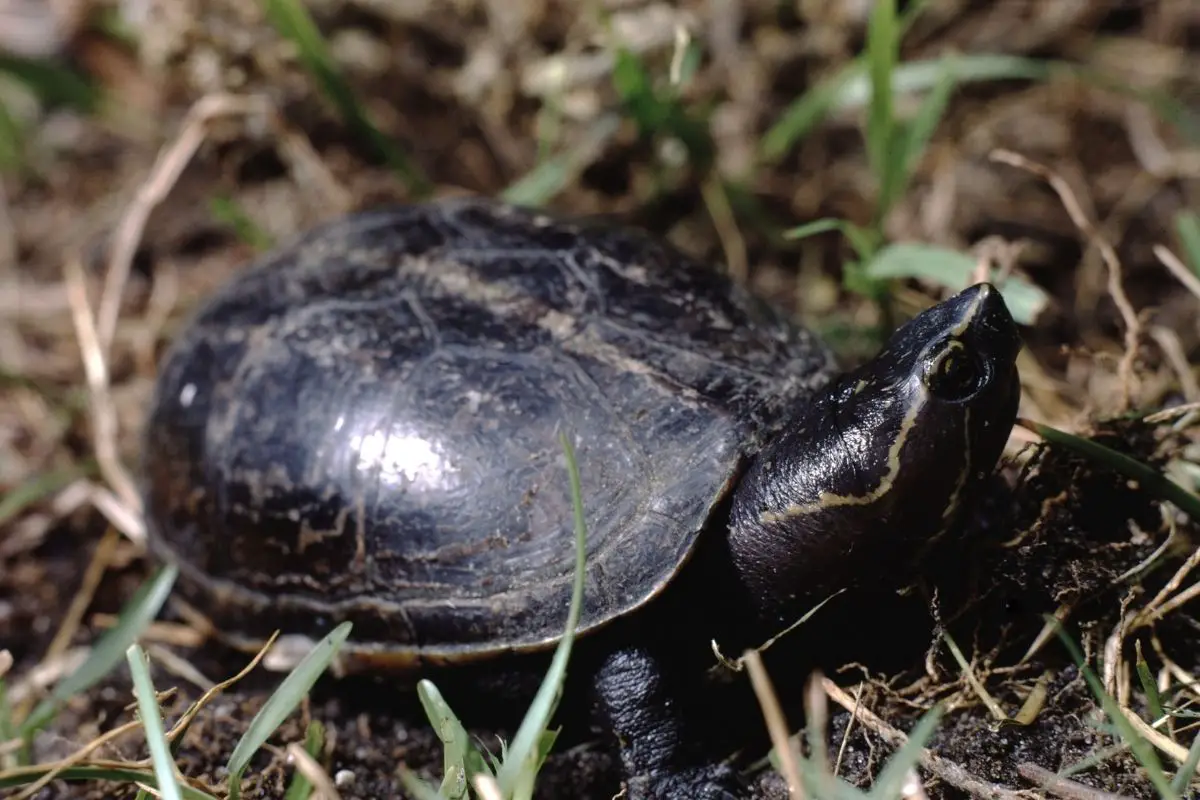
- Name: Kinosternon Baurii
- Family: Kinosternidae
- Maximum Size: 4 and 5 inches
- Lifespan: 50 years
The Striped Mud Turtle gets its name from the 3 bright yellow stripes that run down the center of the turtle’s dark brown shell.
You can also see these bright yellow stripes running across their face between their eyes and nose. The markings are a lot more noticeable when the turtle is wet.
These turtles are a new discovery in Maryland. As a result, they have only been found in a few counties to date. Typically, they have been spotted in rivers or creeks that are close to forested floodplains.
The Striped Mud Turtle likes to roam large distances and live off an omnivore diet. Thus, they mainly eat worms, fish, mollusks, and invertebrates. They are also known to eat algae and plants for a varied diet.
Common Musk Turtle
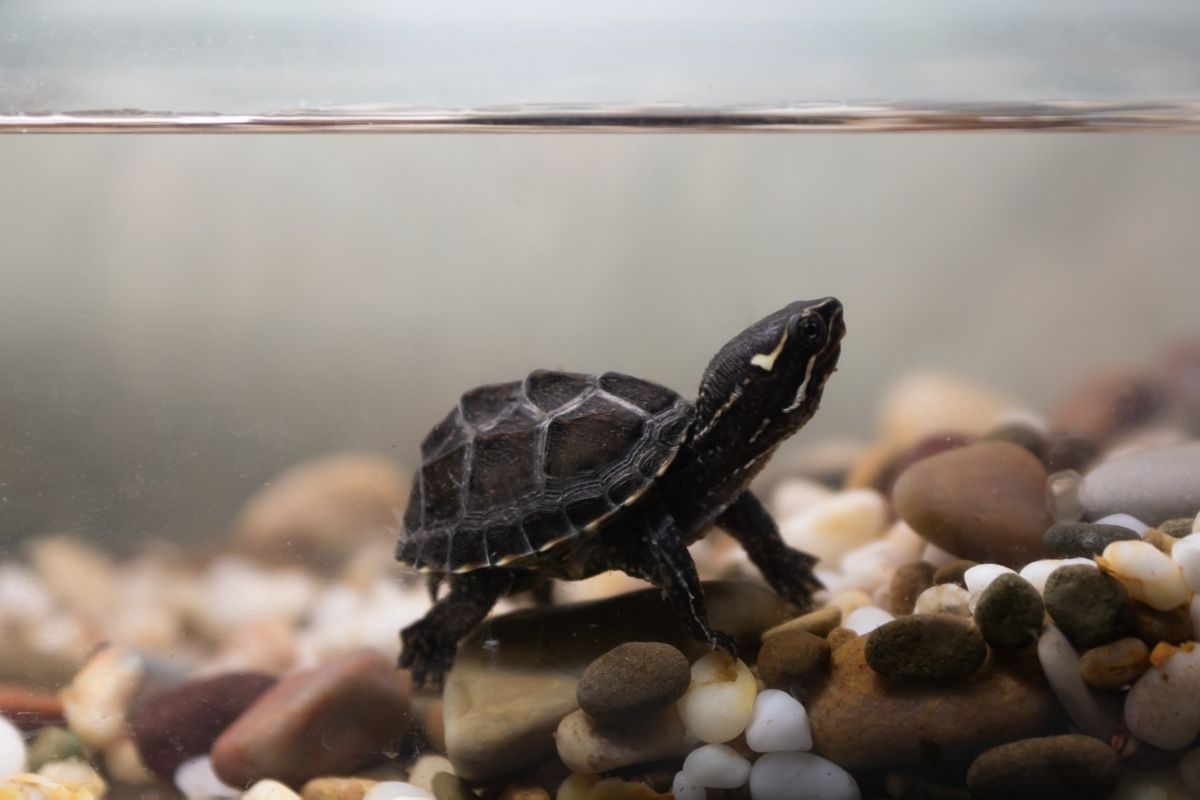
- Name: Sternotherus Odoratus
- Family: Kinosternidae
- Maximum Size: 4 and 5 inches
- Lifespan: 50+ years
The Common Musk Turtle also goes by the name, Stinkpot. This is because of the strong odor that they can produce from their musk glands when they feel provoked or threatened.
This is how these turtles protect themselves from any possible predators. The Common Musk Turtle is very common all throughout Maryland.
These turtles have unmarked yet dark shells. This complements their dark heads that have striking yellow lines on their face. This species of turtle likes marshy areas or permanent bodies of water.
The Common Musk Turtle is known to be able to hunt for its prey by using its scent. This is another turtle species that is an omnivore, but they prefer to eat tadpoles, crayfish, mollusks, and small fish.
It should be noted that they are the strongest swimmers, so they won’t chase prey if they can help it.
Northern Map Turtle
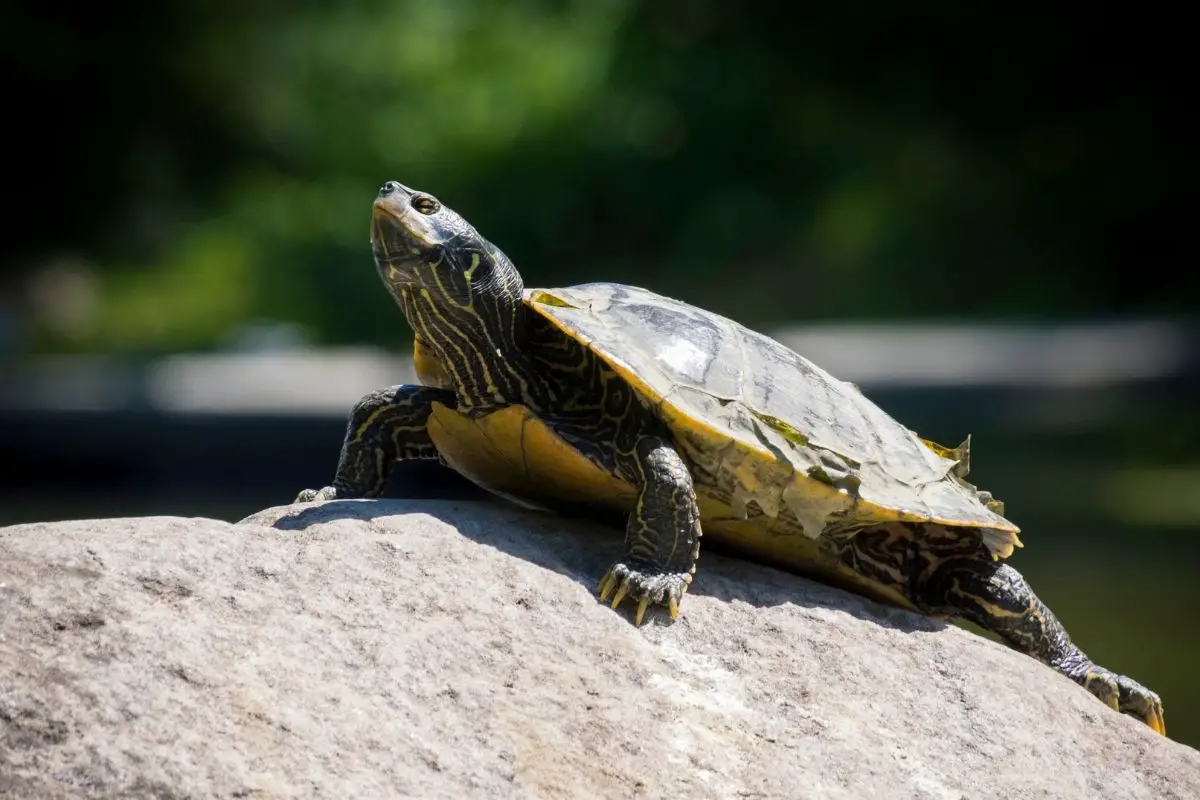
- Name: Graptemys Geographica/Common Map Turtle
- Family: Emydidae
- Maximum Size: 4 and 10 ½ inches
- Lifespan: 15 to 20 years
The Northern/Common Map Turtles are seen as endangered in Maryland. Thus, they are only spotted in the northern counties.
The most common area to find them is near the Susquehanna River. This species of turtle love the water and don’t travel too far away from the river. They are fantastic swimmers, but they do also enjoy spending their time basking as well.
This type of turtle has an olive-green to dark-brown shell. The markings are yellow and resemble the contours of a map. This is where they get their name from.
There are many subspecies of the Map Turtle, and small yellow dots that are behind the eye are what can differentiate the Northern Map turtle from other map turtles.
Unlike other turtles we have spoken about, the Northern Map Turtles are carnivores. They will usually eat aquatic invertebrates, fish, and plants.
Northern Red-Bellied Cooter
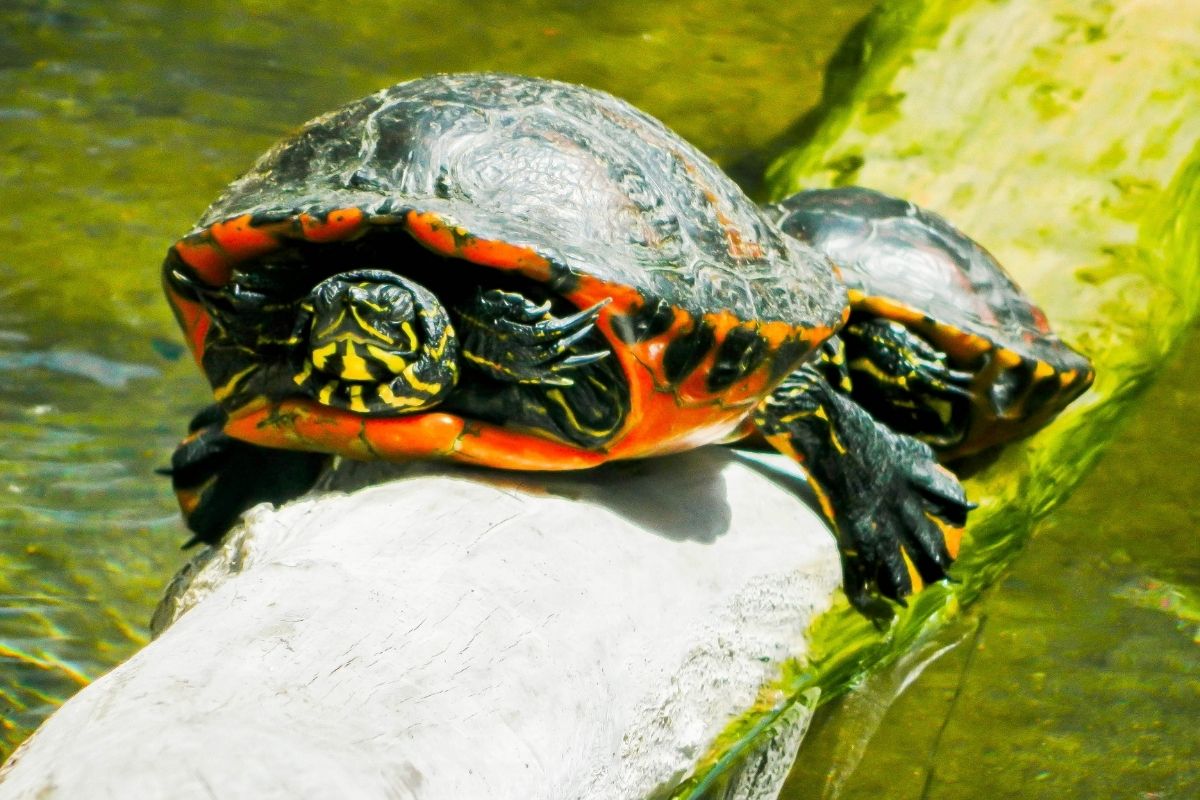
- Name: Pseudemys rubriventris
- Family: Emydidae
- Maximum Size: 8 and 12 ½ inches
- Lifespan: 40 and 55 years
The Northern Red-bellied Cooter is seen as the largest species of pond turtle found in North America. They are often seen in ponds or rivers that have brackish water and a soft bottom surface.
When it comes to their personality, they love to bask, but they are very shy and cautious creatures.
These turtles get their name from their bright red-colored underside to their shell, otherwise known as their plastron. You can also see red lines on the scutes on their shells as well.
Compared to the bright underside, these turtles typically have a black to olive green-colored shell. Their skin is naturally quite dark, but they also have vibrant yellow lines on their skin as well.
The Northern Red-bellied Cooter is an omnivorous turtle. However, younger Red-bellied Cooters will eat more meat than the adults, who live off far more plants and vegetation.
Painted Turtles
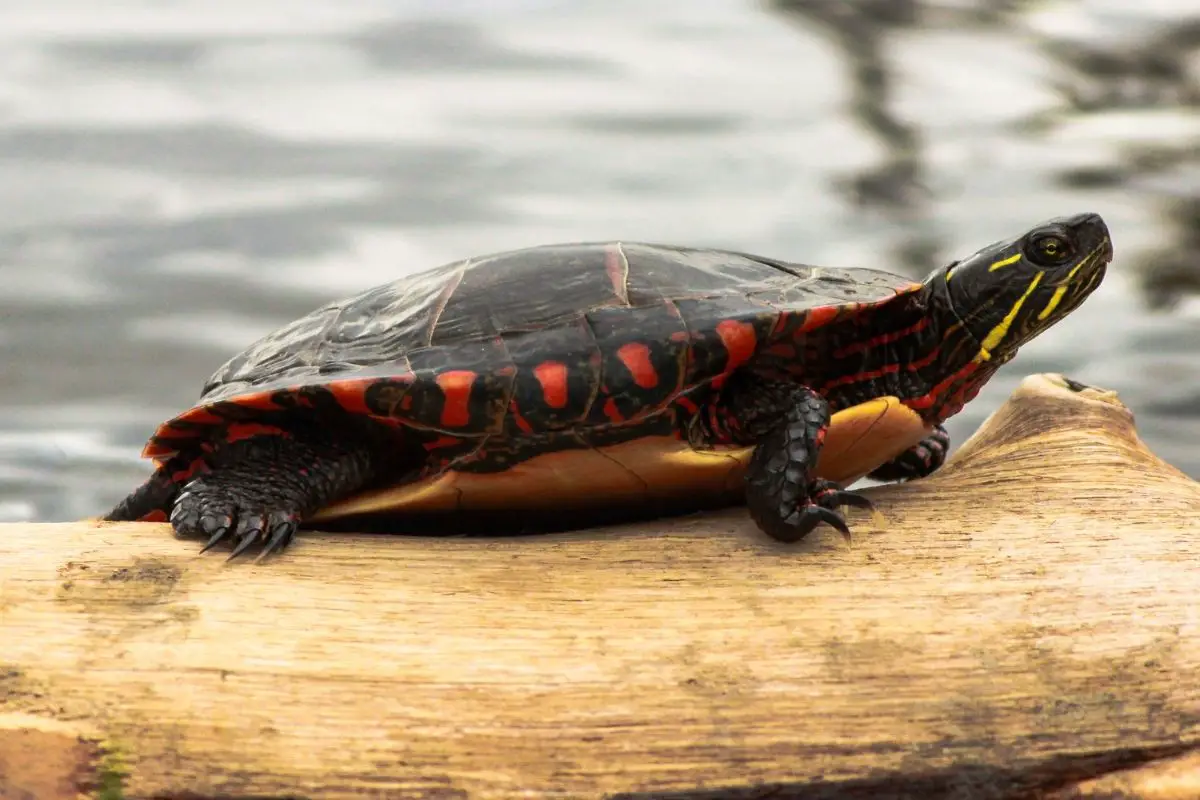
- Name: Chrysemys Picta
- Family: Emydidae
- Maximum Size: 4 and 10 inches
- Lifespan: 30 and 50 years
Painted Turtles are quite a common sight throughout Maryland. In particular, the Midland Painted and Eastern Painted Turtles are two subspecies that are native to Maryland. They are also a very popular choice to be kept as a pet.
Generally, a Painted Turtle will have a dark shell alongside striped yellow markings, which can be quite faint to see.
The Eastern Painted Turtle has an orange to the red underside with yellow and black markings. While the Midland Painted Turtle has a shadow-like dark marking in the center of their plastron.
These species of turtle love the water. Usually, the painted Turtle will live near water, but they still enjoy basking.
Alongside this, they have an omnivorous diet where they eat frogs, underwater invertebrates, and mollusks. However, it should be noted that these turtles can only swallow food while they are in the water.
Common Snapping Turtle
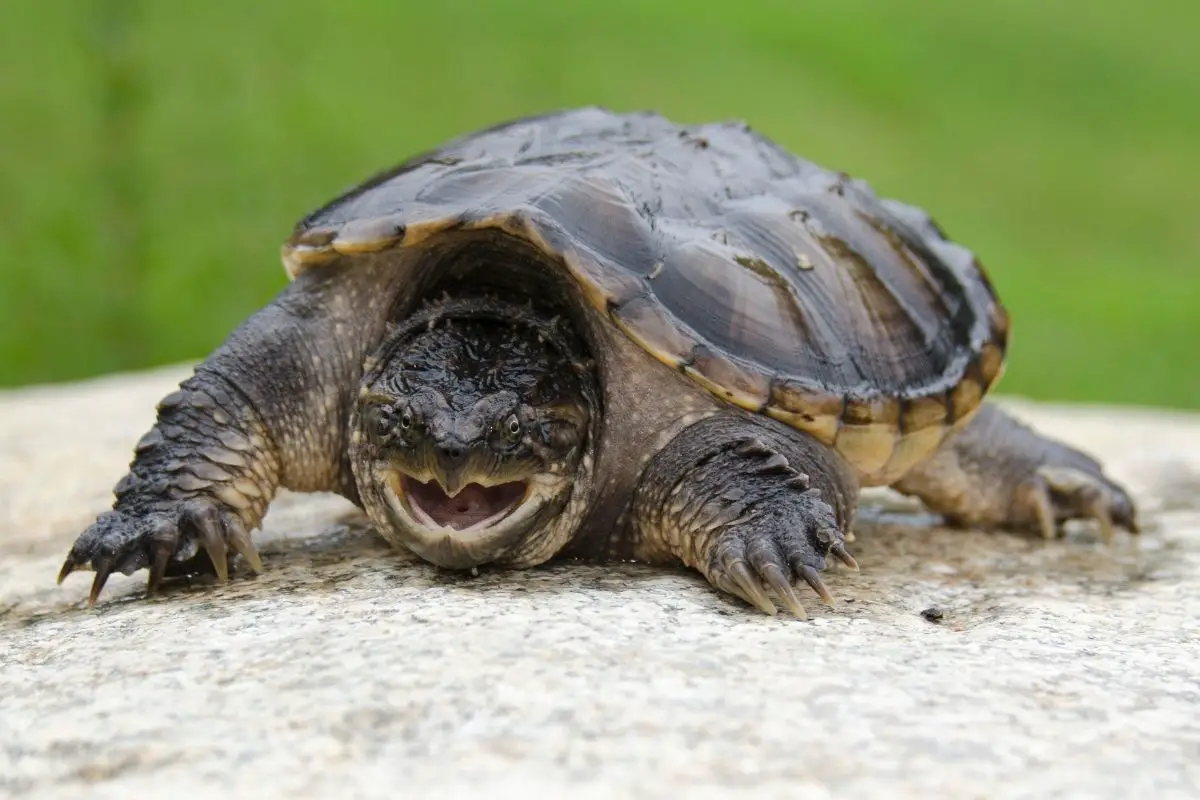
- Name: Chelydra serpentina
- Family: Chelydridae
- Maximum Size: 8 and 20 inches
- Lifespan: 30 and 50 years
The Common Snapping Turtle is known as the largest freshwater turtle that is native to Maryland.
You can find these turtles in any kind of water all over Maryland. However, you should be careful when approaching these turtles, as they are very aggressive turtles and are known to bite and hiss at people.
These turtles are quite common as they don’t bask that much compared to other turtles and like to stay in the water for long periods of time.
The Common Snapping Turtle has a very distinctive appearance. It is easy to spot this species by the hooked beak on their face, which is incredibly sharp.
They are known for having a dinosaur-like appearance with a sharp beak, long spiked tail, and sharp claws. Their shell is typically green or dark brown.
This species of turtle enjoys eating a balanced diet of aquatic prey and fish. However, they do enjoy eating aquatic vegetation and plants.
There have also been reports that Snapping Turtles will hunt and eat small water birds if they get too close.
Spiny Softshell Turtle

- Name: Apalone Spinifera
- Family: Trionychidae
- Maximum Size: 5 to 17 inches (depending on the gender of the turtle. Males are much smaller than females)
- Lifespan: 20 to 50 years
The Spiny Softshell Turtle is known for its very flat, almost pancake-shaped shell, which features dark circle markings. This shell has a leather-like texture to it.
It is known that these turtles don’t like to be handled and will bite or scratch if they have been caught and are handled.
At the moment, it is known that these turtles can only be seen in the west of Maryland in Garrett County.
It is known that they do require a sandy environment so that they can borrow for safety and to lay their eggs. They will sleep in the burrows that they have made, but are seen on the surface during the day.
The Spiny Softshell Turtle enjoys swimming and likes to feed on mollusks, crustaceans, and invertebrates. They will also sometimes eat aquatic vegetation as well.
Spotted Turtle
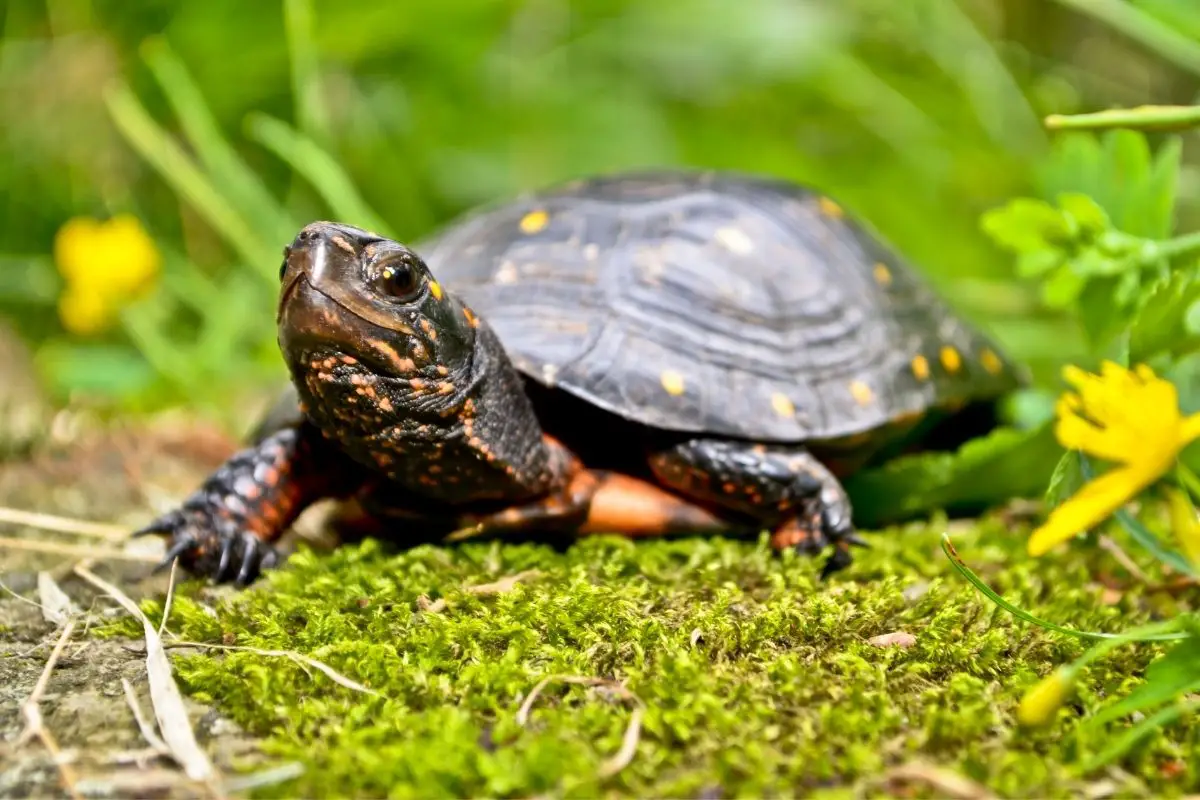
- Name: Clemmys Guttata
- Family: Emydidae
- Maximum Size: 4 and 5 inches
- Lifespan: 25 and 50 years
The Spotted Turtle is a semi-aquatic species of turtle that likes shallow water. They are often seen in marsh or wetland habitats.
When it comes to basking, the Spotted Turtle will perch themselves on a log near the water. However, they also like areas that have soft ground, so they can walk away from the water easily.
These turtles have smooth black shells, which are covered in small, vibrant yellow dots. Compared to their plastron, which is the opposite. It is yellow with black patches of various different sizes.
A very common species of turtle in Maryland. They enjoy feeling vegetation, mollusks, invertebrates, and crustaceans.
Wood Turtle
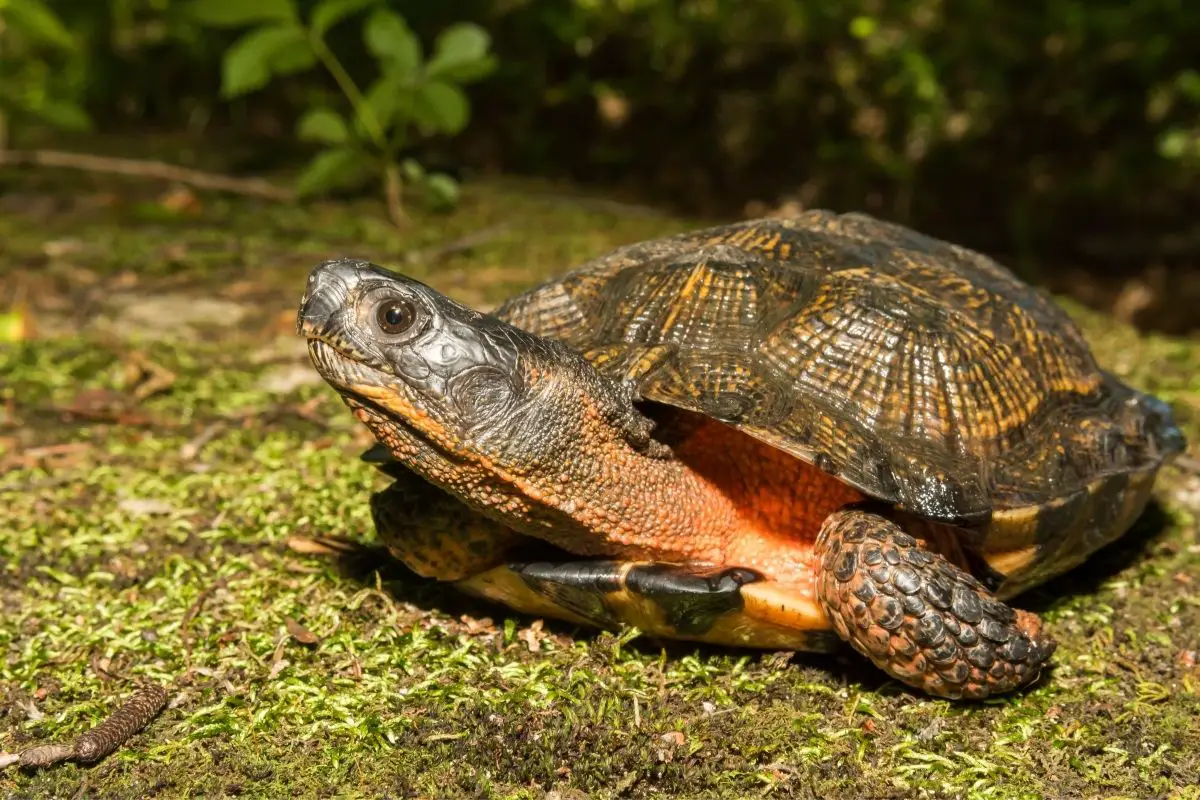
- Name: Glyptemys Insculpta
- Family: Emydidae
- Maximum Size: 5 ½ to 8 inches
- Lifespan: 40 years (wild), 58 years (captivity)
The Wood Turtle is located in the western areas of Maryland. These turtles are like a pond or woodland habitat. Yet, they are considered to be very intelligent turtle species.
These species get their name from the appearance of their shell. Their shell looks like wood, with a pattern resembling wood grain and growth rings.
It is also said that their shells feel really rough, like wood as well. They have pyramid-shaped scutes, and their shell is mainly brown.
During the day, the Wood Turtle will roam for meters to look for food. As they are such clever creatures, they can rock on the soil, which causes vibrations.
This then causes worms to believe it is raining and come to the surface. These turtles enjoy eating worms, earthworms, mollusks, berries, and plants.
Non-Native Species Of Turtles In Maryland
Not all the turtles you find in Maryland are native species. There are 3 other species of turtles that are seen in Maryland that are not native to the area.
These species have been introduced to Maryland, and if you spot any of them, you should report their sighting. These are the following species.
False Map Turtle
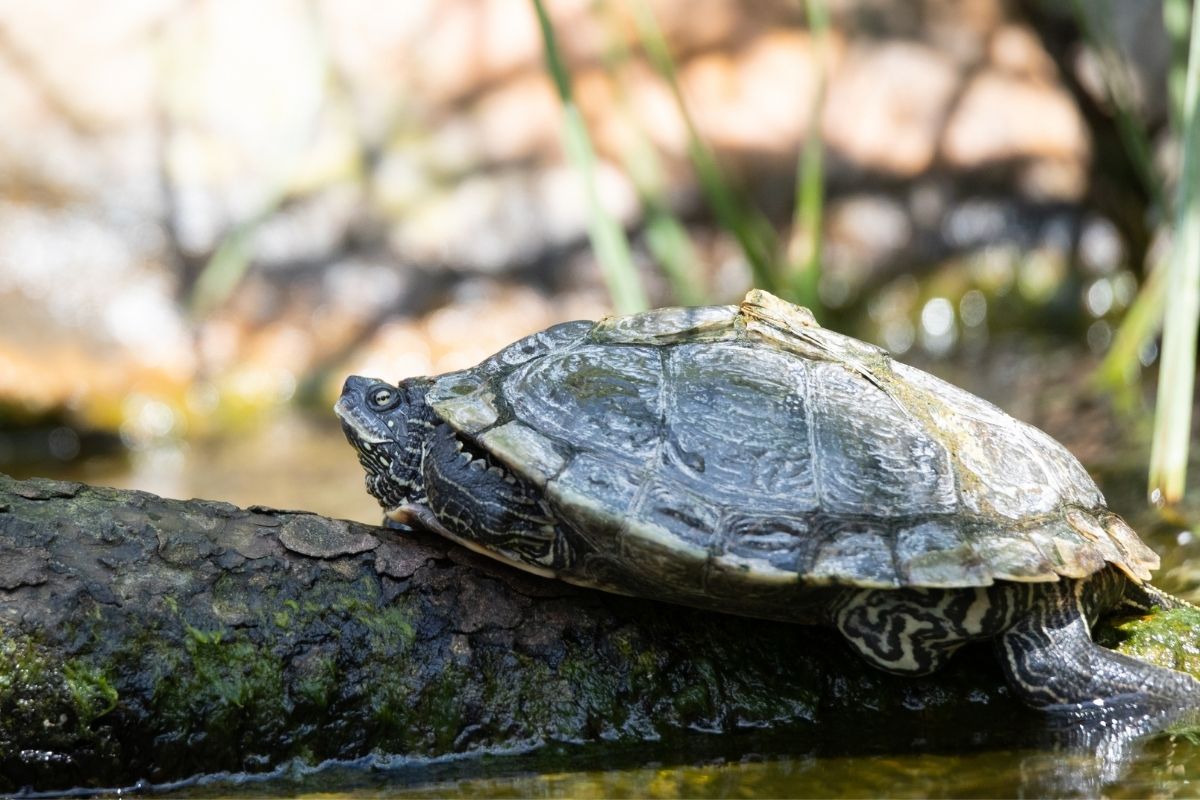
- Name: Graptemys Pseudogeographica
- Family: Emydidae
- Maximum Size: 3 ½ and 10 ½ inches
- Lifespan: 30 and 50 years
The False Map Turtle isn’t native to Maryland, yet it has been seen in the Northern areas of Frederick County. These turtles don’t like to roam too far away from water and like to bask on the water’s surface.
They have quite a dark-colored shell, being either black or brown. Yet they also have yellow markings that contour the shell.
However, as this species of turtle gets older, these yellow markings begin to fade more and more. Alongside this, a lot of adult False Map Turtles have a keel on their shell.
What distinguishes the False Map Turtle from other Map turtles is that they don’t have any markings or patches on their heads. The False Map Turtle likes to seed on aquatic plants and invertebrates.
Red Eared Slider

- Name: Trachemys Scripta Elegans
- Family: Emydidae
- Maximum Size: 6 and 8 inches
- Lifespan: 20 and 40 years
The Red-eared Slider is a very popular and common type of turtle to have as a pet. They are often seen in central and northern areas of Maryland.
They are a semi-aquatic species of turtle, as they like to bask on the edge of the water. However, they do favor much more slow-moving and warmer water.
Generally, this species of turtle will have an olive-green shell featuring yellow-striped markings. Whilst their heads are an even darker color with these same yellow patterns.
Also, you will notice two distinctive red patches behind their ears, which is what gives this turtle its name.
The Red-eared Slider is a known omnivore. They like to feed on aquatic vegetation and invertebrates, and small fish.
Yellow-Bellied Slider
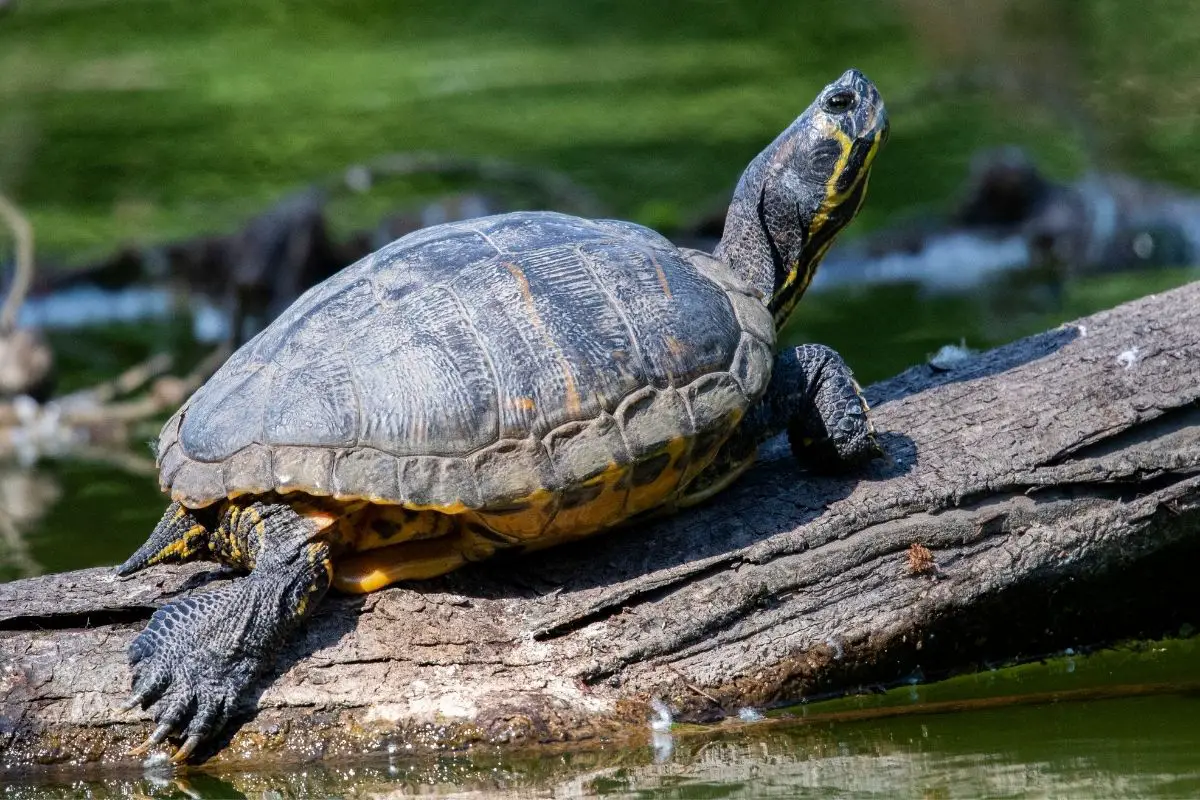
- Name: Trachemys scripta scripta
- Family: Emydidae
- Maximum Size: 5 and 12 inches
- Lifespan: 20 and 40 years
The Yellow-bellied Slider is a new discovery in Maryland, but they are native to the area. You can see them in lakes and rivers and in ditches that are full of water.
Just like their name suggests, this turtle has a yellow plastron alongside yellow markings and patches on its shell and skin. These markings and patterns also cover their legs as well.
You will see these turtles active during the day and basking on the land in the sun. When it comes to their diet, they like to consume mollusks, tadpoles, small fish, and aquatic plants.
Sea Turtles Found In Maryland
There are 54 species of sea turtles that you will see off the coast of Maryland. Obviously, you cannot keep these turtles as pets, but if you are lucky to see one in the wild, there is no harm in knowing some extra information about them.
Green Sea Turtle
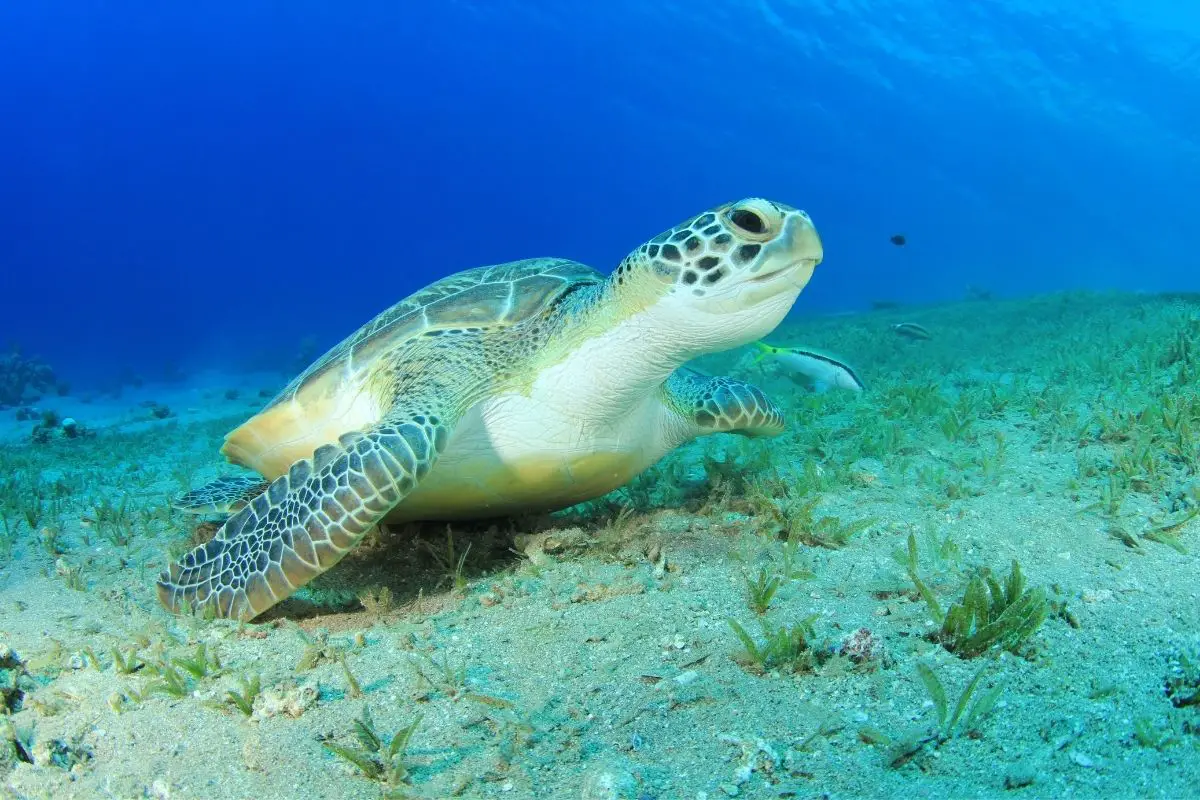
- Name: Chelonia Mydas
- Family: Cheloniidae
- Maximum Size: 3 and 4 feet
- Lifespan: 80 and 100 years
The Green Sea Turtle has been classed as an endangered species of turtle. You will often see them in the summer months around Maryland near the coastlines and bays or in the open ocean waters.
They have a smoother brown to green heart-shaped shell. The edges of the shell have a slight yellow tint to them. At the same time, their skin has a cream color with hints of green. Their skin can look quite scaly.
The Green Sea Turtle is a herbivore and will eat seaweed, algae, and seagrass.
Hawksbill Sea Turtle

- Name: Eretmochelys Imbricata
- Family: Cheloniidae
- Maximum Size: 30 and 35 inches
- Lifespan: 30 and 50 years
The Hawksbill Sea Turtle is considered to be critically endangered as it keeps being accidentally caught in fishing nets.
They enjoy tropical reefs, waters, and estuaries. At the same time, they can also be seen in shallow areas with rocky waters.
These sea turtles have an amber-colored oval-shaped shell with unique markings.
What gives them their name is their very distinctive beak-shaped mouth, which looks like the beak of a hawk. Alongside that, these turtles have claws on the end of their flippers.
They live off an omnivore diet of algae, crustaceans, and mollusks.
Kemp’s Ridley Sea Turtle

- Name: Lepidochelys Kempii
- Family: Cheloniidae
- Maximum Size: 25 inches
- Lifespan: 30 years
The Kemp Ridley Sea Turtle is another sea turtle that has been classed as critically endangered due to being caught on fishing lines and nets. These turtles prefer shallow water along muddy or sandy coastlines.
Appearance-wise, these turtles have a round gray to green shell with a triangular-shaped head. Their plastron is a yellow to muted cream color.
They also have a hooked beak, ideally for hunting as they enjoy feeding on shellfish and crustaceans.
Leatherback Sea Turtle
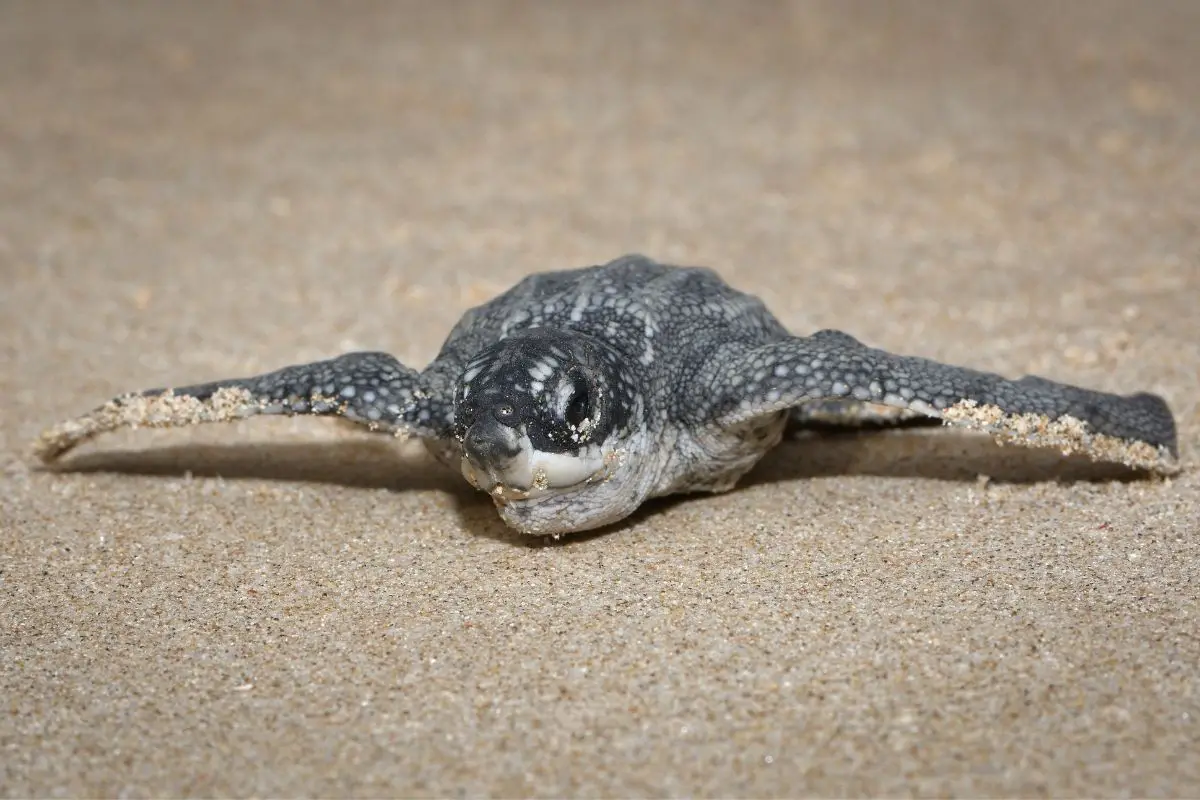
- Name: Dermochelys Coriacea
- Family: Dermochelyidae
- Maximum Size: 6 and 7 feet
- Lifespan: 30 years
The Leatherback Sea Turtle is one of the largest sea turtles you will ever face. Compared to the other sea turtles we have mentioned, they are only classed as vulnerable, but they aren’t as threatened as some of the other species we have mentioned.
They enjoy calm, warm, and shallow water, such as lagoons and bays. However, they will commonly nest on a sandy beach.
These turtles actually have a soft shell, instead of a typical hard shell. Having a soft shell is a unique thing for a sea turtle to have.
Alongside this, their soft shell is ridged at the edges and can be seen in various colors, from dark gray to black.
The Leatherback Sea Turtle has a jellyfish-heavy diet, but they do like to eat other sea creatures as well.
Loggerhead Sea Turtle
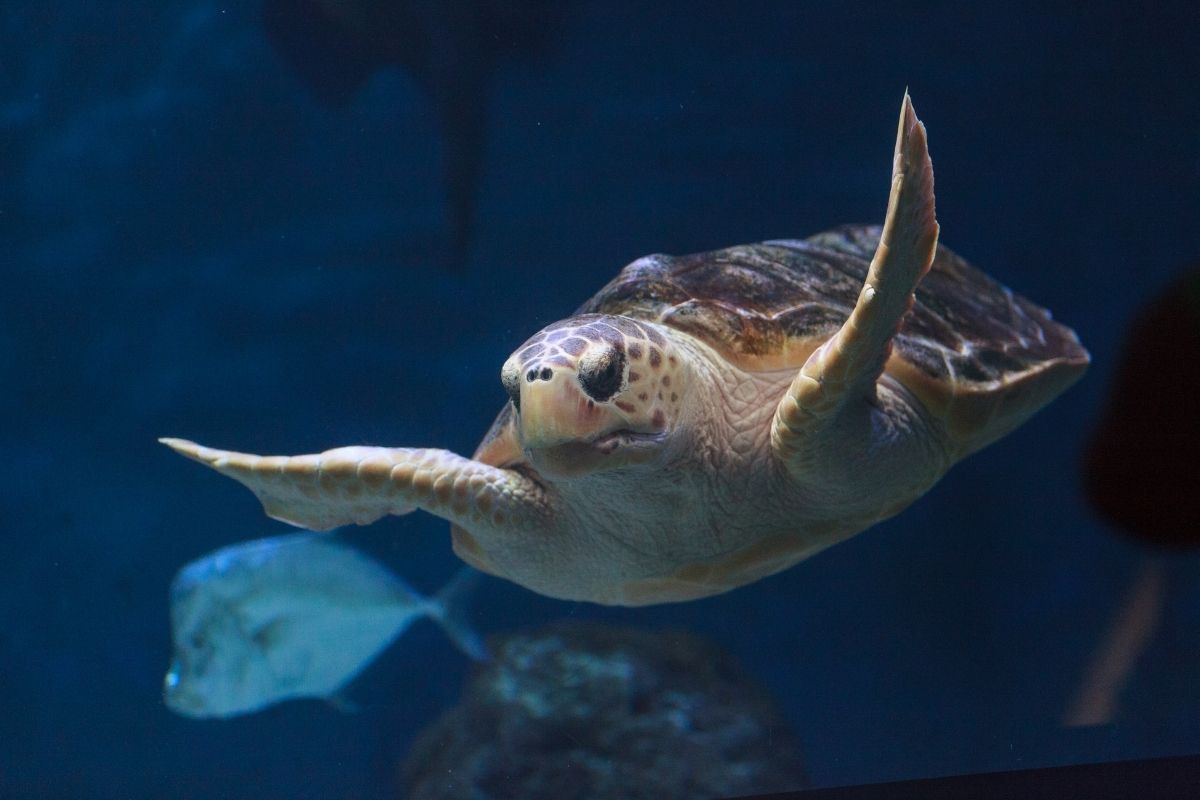
- Name: Caretta Caretta
- Family: Cheloniidae
- Maximum Size: 30 and 45 inches
- Lifespan: 70 and 80 years
The Loggerhead Sea Turtle has been classed as an endangered species of sea turtle. Often you can see these turtles in shallow bays in coastal areas, but they favor subtropical water when it comes to nesting—these turtles like a good sandy beach.
Appearance-wise, these turtles are known for having a large head with their hard-shelled brown to red shells. Their plastrons are typically yellow to cream in color. They also have long flippers, which are quite powerful to help them swim.
These turtles enjoy a carnivore diet of shellfish, crustaceans, and mollusks.
Frequently Asked Questions
Is It Legal To Keep Box Turtles In Maryland?
It is illegal to remove a turtle from the wild, and it is illegal to own a turtle that is under 4 inches in length. Also, non-native turtles are not allowed to be released from captivity into the wild.
Can You Buy Turtles In Maryland?
You can purchase a turtle in Maryland from a licensed seller. You can only sell turtles in Maryland if you have a license or a permit.
Where Do Turtles Go During Winter In Maryland?
Freshwater turtles will dive to the bottom of their pond or water as the temperature won’t drop below 1 degree.
In the mud at the bottom of the water, this slows their metabolism down to allow them to survive the cold months with little food or oxygen.
Final Thoughts
In this article, we have covered all the species of turtles that you will find in Maryland.
Out of all these species, 13 of these species of turtles are actually native to Maryland. Some of these turtles are quite common, while others are rare.
We have also discussed the 3 non-native turtle species that you see in Maryland.
These species are known to have been released into the wild from captivity. If you see any of these turtles, then you must report them to the correct wildlife authorities.
Finally, we looked into the 5 sea turtle species that have been spotted around Maryland. The majority of these turtles are endangered and should be treated with respect.
Now you know all the species of turtles that you can spot the next time you go to Maryland in search of turtles.
